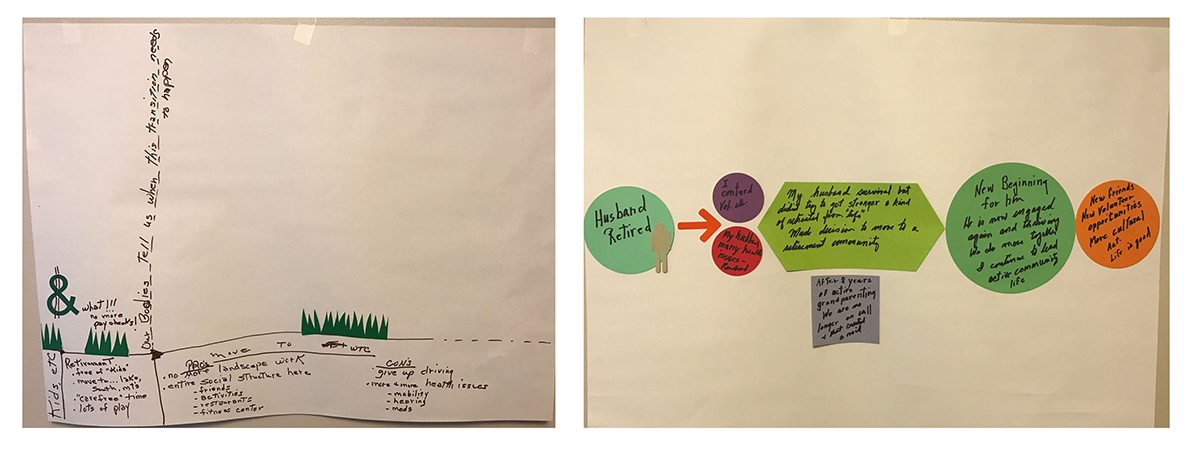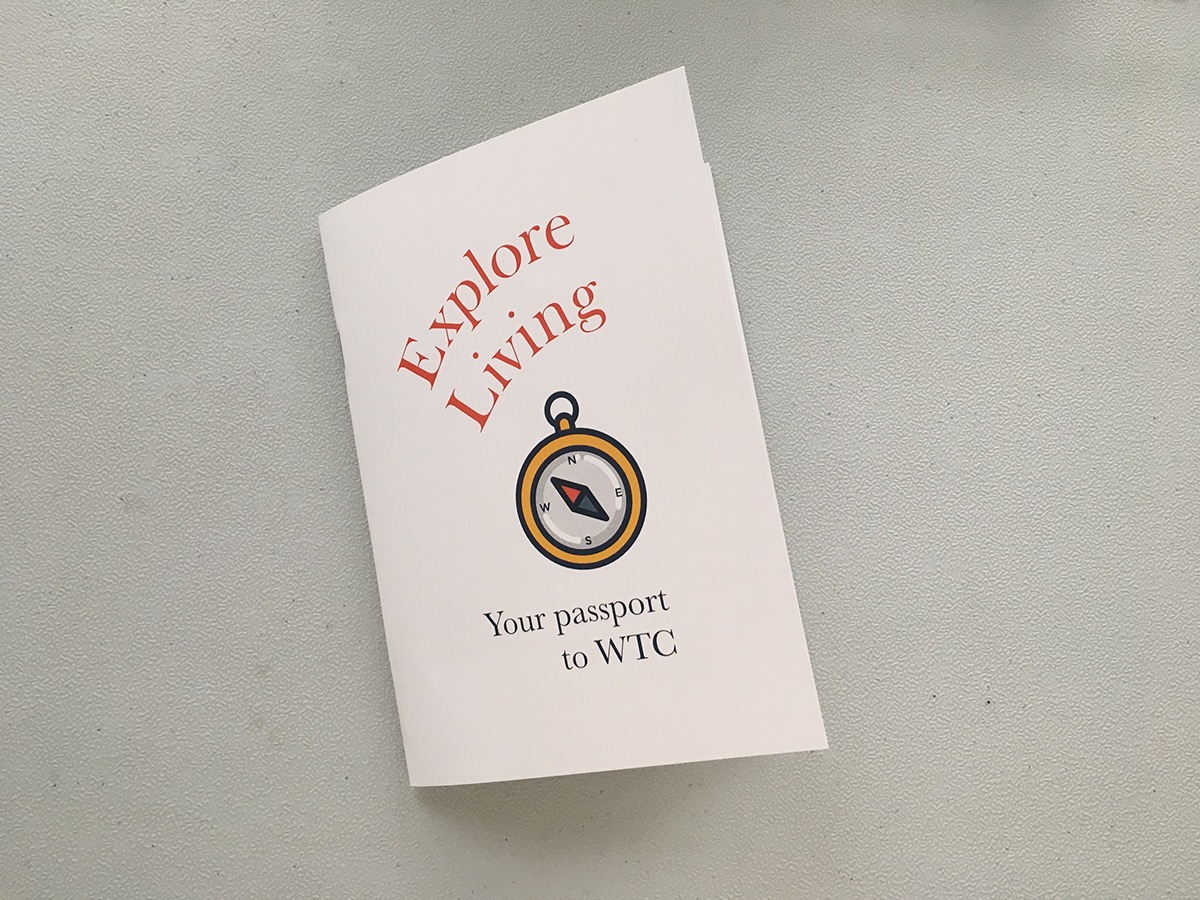In this project, I worked with 2 graduate students and co-designed with the residents of Westminster Thurber, an older adults residency in Columbus, Ohio. This project is a result of studio-based participatory/ co-design project where design teams and older adults from the Westminster Thurber Community (WTC) worked together to understand what possible new services, processes or products could improve the quality of life and help older adults transition into new environments when they move.
We met once a week for 10 weeks and designed a product for the new residents, moving into WTC facility. It was a great experience designing with a team with students from other disciplines like business (Jay De Laney) and psychology (Shasha Yu). This project was a great opportunity to collaborate with older adults and learn from their expertise.
FINAL DESIGN
After various prototyping and testing, final outcome was ready to be used by the residents recently moved to WTC. It was aimed for new/new-ih residents to recieve a passport to explore the facility. When a resident checks off all of the items in the passport, they receive a special prize.
We explored further this concepts mainly because residents (our participant group) liked the idea. Then we brainstormed ideas of places, activities, and spontaneous behaviors we could include in the passport.
DESIGN & RESEARCH PROCESS
We met each week and assigned homeworks and analyzed the outcomes of our meeting weekly. In the introductory week all 11 students and 24 residents from WTC met and brainstormed for the possible topics and problems to study for 10 weeks. In the end of the first session participants came up with 4 different topics. Therefore, 4 design research groups emerged from the brainstorming session. We discussed the possible problems older adults are experiencing and tried to group the topics to discuss through the rest of our meeting.
1. DEFINING THE PROBLEM
Participants in my group decided to explore "Transitions". First goal was identifying the key transitioning points after the retirement. Firstly, we discussed transitions and reviewed the issues related to transitioning into a new life style; starts with retirement.
Secondly, each participant are asked to express their definition of transition on a piece of paper, using optional materials that might help them such as post-it notes, markers, and paper cut shapes. First goal was identifying the key transitioning points after retirement.

We broke out the first group session into 3 parts. First our participants shared their experiences and information about the retirement, then created as a 'timeline' to represent the retirement experience individually, then based on the discussions and outcomes, they created a timeline all together.

Participants creating their 'timeline' in other words retirement experience.


Individual Timelines. They did a great job, helped us understand major problems and started to define our focus as a group.

Group timeline. They put together a summarized diagram.
“Community” was identified as a key theme - the role of community and how to facilitate/encourage community throughout transitions
We also identified 8 transition points as potential topics for our project
Key Findings
Question: What is the role of the community in each of the transitioning steps?
Aim: How to facilitate/encourage/build community to support each other?
1. Children moving out
2. Relocation
3. Loss of a loved one/spouse
4. Transitioning into the community/ Becoming part of the WTC
5. How to engage people who aren't part of the community?
6. Companionship for people in rehab
7. Helping to learn how to be with and support someone who is dying
8. Legacy




Top 2 Results
1. Encouraging community throughout all of these transitions
2. Transitioning into the community, Becoming part of WTC
Refined Problem
After discussing the results, people agreed on the following topic for our project:
Welcoming people into the Westminster Thurber Community
To provide additional focus, we had a discussion about what type of outcome would be most helpful: a book, an event, a website, a welcome packet, a video, or some other piece
We also provided a pile of photos to help people express their ideas

Options of final outcome, presented to our participants, so they can choose.
By the end of our discussion, we identified three potential projects:
- Developing a book/binder/welcome packet
- Developing a buddy system
- Developing a process to create consistency in how people are welcomed regardless of which floor/building they move into
Exploring “Feeling Welcomed”
I feel welcomed . . .
- “When someone calls me by my name”
- “When spontaneity is the order of the day”
- “If someone invites me to eat with them”
- “When people introduce themselves to me”
- When someone offers to do an act of kindness for me

"Feeling welcomed" key notes listed by our participants
"Feeling Welcomed" Another Exploration:
Using the sandbox - exercise to encourage people to show what made them feel welcomed
Three key possibilities emerged:
(1) Using information to welcome people
(2) Fostering relationships to welcome people, and
(3) Being mindful of the different needs that people with different personalities may have
(2) Fostering relationships to welcome people, and
(3) Being mindful of the different needs that people with different personalities may have
An idea Emerged:
A Treasure hunt that makes a game out of getting to know Ohio Living- Werstminster Thurber Center.
Concept Exploration - The WTC Passport
We (the students) shared a concept based on The Columbus Ale Trail Brew Book

Our inspiration on concept designs.
Proposed Idea:
New / new-ish residents receive a passport to explore WTC. When a resident checks off all of the items in the passport, they receive a special prize
Residents liked the idea. Then we started to brainstorm on ideas of places, activities, and spontaneous behaviors we could include in the passport

Places in WTC residential area to go, activities to do in there, and kind spontaneous behaviors are listed by residents.
Lists:
Places:
General Store, Crossings, Pub, Bistro, Resident’s Workshop, Chapel / Auditorium / Victorian Room, Art Room, Computer Room, Library, Life Enrichment Center, Swimming Pool, Community Center, Conference Room, Rooftop Garden, Carports, Bulletin Board
Activities:
Social Activities
Physical Activities
Learning Activities
Creative Activities
Spiritual Activities
Volunteer Activities
Spontaneous Behaviors:
Greet every stranger you meet
Ask someone new where they are from
Ask to be seated with a dining companion
Invite someone to an activity with you
Invite someone to dinner
Refining the Survey Content
Pre-meeting Homework: We asked the residents to fill out an online survey to rank content that feels most important to include
Survey Results: We provided the residents with the survey rankings and highlighted any that received 4 / 5 or higher
During the meeting: We gave residents blank paper and shapes so they could each individually conceptualize potential layouts of the passport





In order: Survey results and the residents conceptualizing passport layouts.
Refining Content and Layout
Pre-meeting Homework: We asked everyone -including the students- to bring ideas for sketching out layouts for other sections, like physical activities



Layout sketches, in order concepts 1, 2, and 3. Concept 3 was picked.
Refining Content and Layout
Residents recommended keeping the design simple and eliminating unnecessary text, like hours and descriptions. We built from concept 3 that provided the most clean, elegant layout while ensuring the text was large and readable. As a designer, I really appreciated their agreement on simple design.
It became clear that residents believe the passport should focus on encouraging people to explore PLACES and focus less on ACTIVITIES or SPONTANEOUS BEHAVIORS.
We grouped places into four categories: Food / Dining, Physical, Enrichment, and Crossroads / Connectors
A Draft WTC Passport
We shared with the residents a draft passport. Residents provided specific feedback on each section of the draft passport in order to make updates and edits.
The concept for the cover incorporated two different ideas from residents for the name of the book: Explore and Living became “Explore Living”
Each section was organized by category and listed one or more places within WTC. Residents recommended eliminating language from the page and sections, like “Date & Time” and “Where did you eat?” to simplify the content as much as possible.


Final Outcome: A passport design for new residents joined to Ohio-Living community. It is aimed to encourage the residents to explore the facilities and rooms, join activities and make new memories with their friends and other residents. Residents provided specific feedback on each section of the draft passport in order to make updates and edits.
The concept for the cover incorporated two different ideas from residents for the name of the book: Explore and Living became “Explore Living”.
Cover is designed by Barb and Shari, their concept is digitalized by me.


When a resident checks off all of the items in the passport, they receive a special prize.
Facilities are grouped under 4 categories including: Enrichment, Physical, Dining, Crossroads
